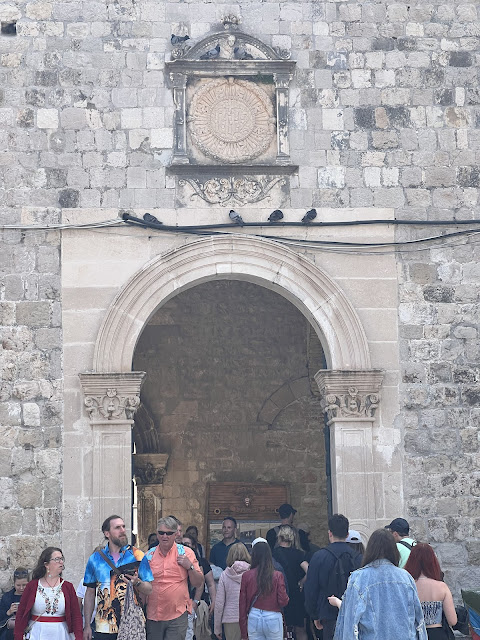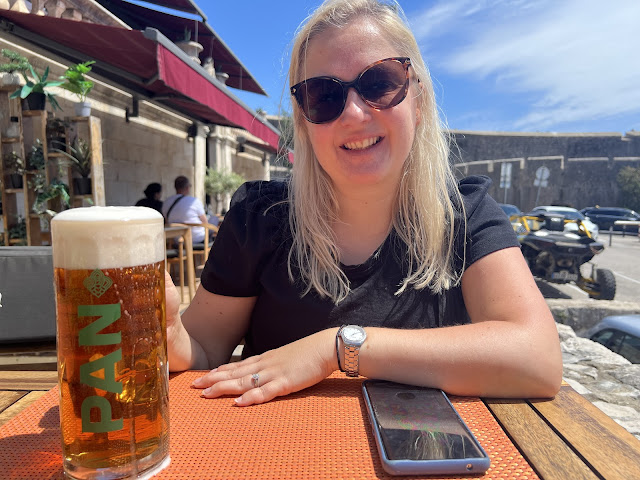History, Food and Wine….again!
I could get used to this breakfast, take note Iain!
We left the hotel just before 10am, with a short walk to the fountain within the city walls on the cards; we are starting the day with a history walking tour with our guide for the next 1.5 hours, Zoran.
The first stop was back outside the walls at St Lawrence Fort where we learned about the first settlement in the first half of the 7th Century. Zoran was a historian, and was keen to tell us everything, which I clearly can’t remember!
After the first stop, we walked back into the walled city via Pile Gate; outside practically every entrance to the city is a statue of St. Blaise, the patron saint of Dubrovnik. You can always tell it is him, as in every statue, he is holding a miniature walled city in his hand.
The next stop was Onofrio’s fountain, built in 1438 and decorated with ornate figures. The fountain also took a direct hit during the Seige in 1991, but it has the most amazing spring water, which you can use to this day.

On one of the side streets is a plaque showing the destruction of Dubrovnik from the Seige which started in 1991, the worst day being 6 December 1991. Most of the guides we have had tours with were here at that time, although Zoran and his family did leave for Germany before coming back to their homeland. It’s hard to imagine as it’s less than 30 years ago, but still a stark reminder of the brutality of some regimes; here, it was Serbia and Montenegro.
After climbing a number of steps, we ended up at the grain store, a huge storage building built in the 16th Century which could feed all the citizens for a year if they were under siege. Why was it up high, I guessed flooding, but causally it was due to humidity. It was much cooler up the steps, therefore the grain was preserved much better.
Thankfully, the only way was down, was via the “Spanish Steps,” so called after the ones in Rome. The actual name is the Jesuit Stairs, as they lead up to the Jesuit Church of St Ignatius of Loyola and the 17th century Jesuit College. At the bottom of the stairs, is the Green Market, where locals can sell locally produced goods , we bought a few food things from here.
Before the final stop, we went out to the port where Zoran explained that this is the only entrance to the city which does not have a statue of St Blaise, why you might ask? Well if you think about it, most of the countries in this area were under the Ottoman Empire at some point in their history, but not here and this was because the city was wealthy and could pay them off. As the Ottomans would enter form the sea, the people did not want a Christian symbol on the gate to anger them, so if you look closely, the symbol looks quite Turkish.
The last stop on the tour was Orlandos column, which stands just beside the clock tower of Dubrovnik. The column was erected in 1418, and according to legend, helped the people of old Dubrovnik (Ragusa) defeat invaders in the middle ages and to remain a free trade city state. Orlandos forearm measured 51.25 centimetre and this was the standard measurement for fabric where local merchants were measuring, cutting and selling fabric.
After our tour, we thought it best to have a coffee, or in my case, a black tea. It’s not easy to get decaf here! We didn’t stay long as we decided it might be a good time to “walk the walls” of the city given the forecasts were for rain the following day. Thank goodness for the Dubrovnik pass, it’s 40 EUR per person for the walls, so the pass really did pay for itself (50 EUR).
The walls are a must-see/must-do, although I don’t think we appreciated quite how bad our knees would feel after all the steps! There are some stunning views, and if you have lots of time, bars to stop for a drink or two. The walls really are so well preserved, and if you think when they were built, it’s very impressive. Lots of pictures to follow…..
After navigating our way back down,we headed back towards our hotel and to a place called Fortezza. We needed a beer to cool off, and decided to share a portion of garlic bread too. It was so hot, and the beer was very refreshing!























.jpeg)
.jpeg)
Comments
Post a Comment